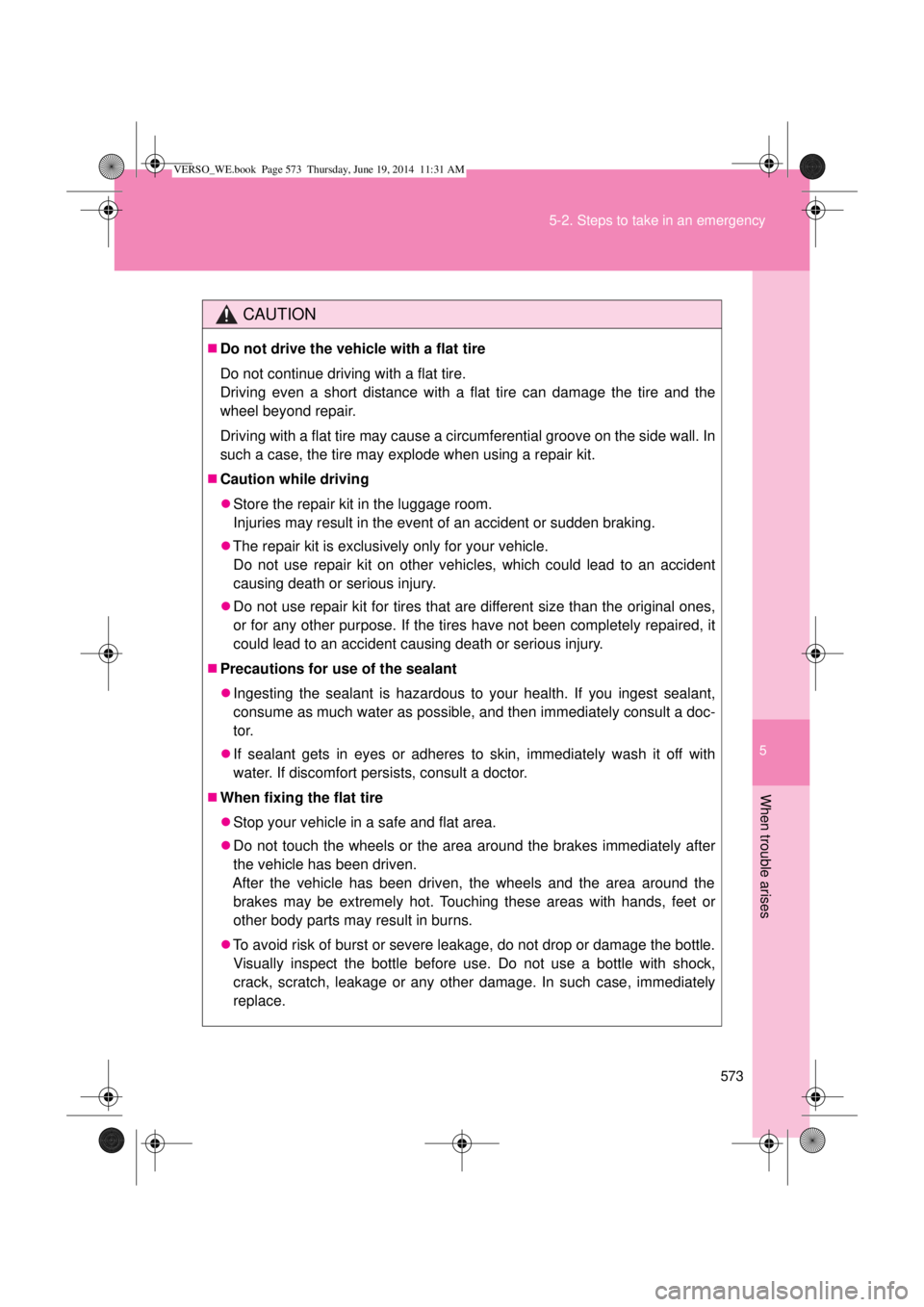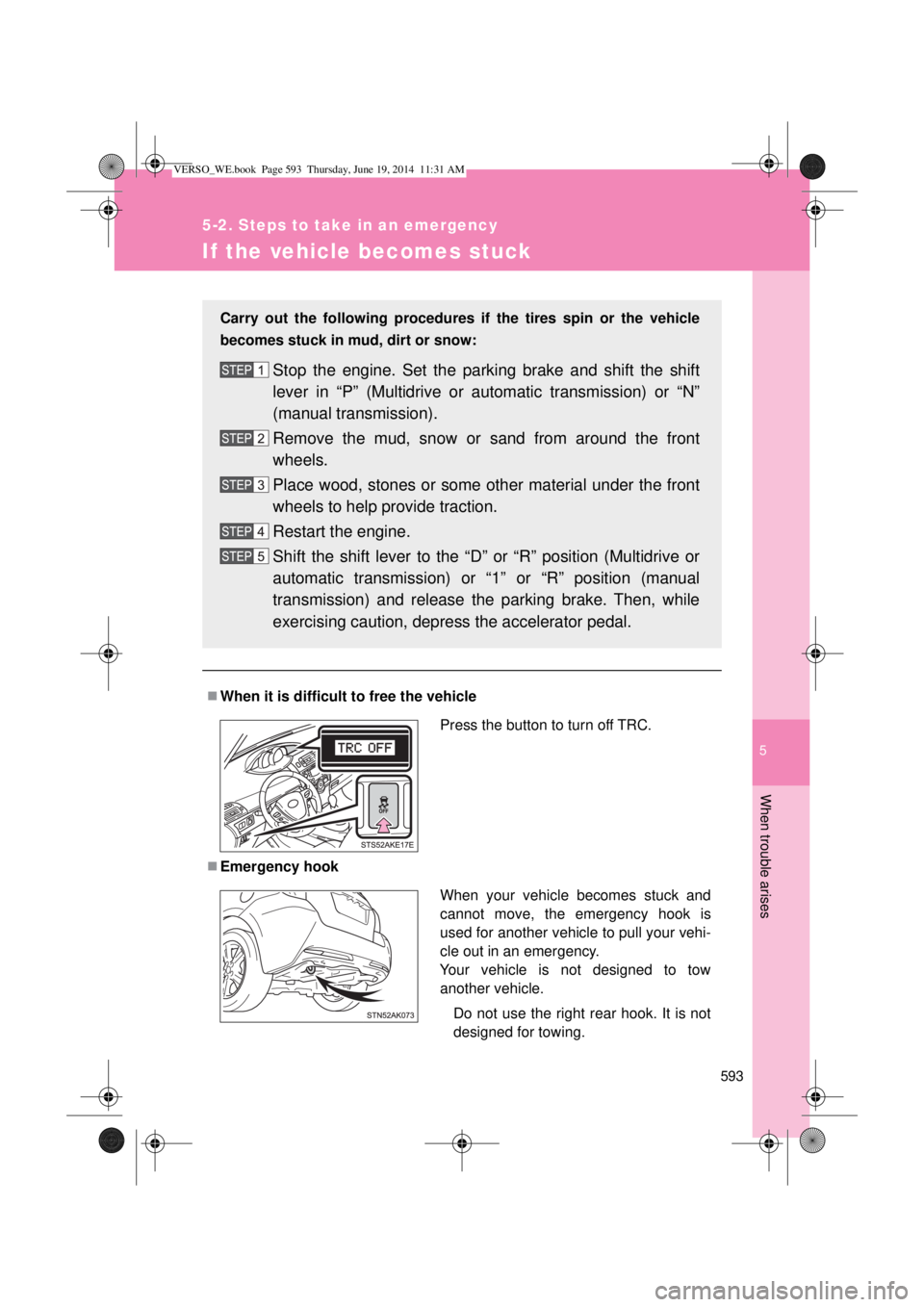Page 557 of 650
5
557 5-2. Steps to take in an emergency
When trouble arises
Taking out the emergency tire puncture repair kit
Open the rear deck board. (P. 393)
Take out the emergency tire puncture repair kit. (P. 553)
In the following cases, the tire cannot be repaired with the emergency
tire puncture repair kit. Contact any authorized Toyota dealer or
repairer, or another duly qualified and equipped professional.
When the tire is damaged due to driving without sufficient air pressure
When there are any cracks or damage at any location on the tire, such as
on the side wall, except the tread
When the tire is visibly separated from the wheel
When the cut or damage to the tread is 4 mm (0.16 in.) long or more
When the wheel is damaged
When two or more tires have been punctured
When more than 2 sharp objects such as nails or screws have passed
through the tread on a single tire
When the sealant has expired
VERSO_WE.book Page 557 Thursday, June 19, 2014 11:31 AM
Page 563 of 650
5
563 5-2. Steps to take in an emergency
When trouble arises
If the pressure is 130 kPa (1.3
kgf/cm2 or bar, 18 psi) or above,
fill the tire with air using the com-
pressor until the specified infla-
tion pressure is reached.
If the pressure is less than 130
kPa (1.3 kgf/cm
2 or bar, 18 psi),
the emergency repair that has
been performed is not safe for
use as damage to the tire is too
severe. Do not continue to drive
the vehicle. Contact any autho-
rized Toyota dealer or repairer, or
another duly qualified and
equipped professional.
Attach the 2 stickers as shown.
Remove any dirt and moisture
from the wheel before attaching
the label. If it is impossible to
attach the label, make sure to tell
any authorized Toyota dealer or
repairer, or other duly qualified
and equipped professional when
you have them repair and replace
the tire that sealant is injected.
VERSO_WE.book Page 563 Thursday, June 19, 2014 11:31 AM
Page 564 of 650
564 5-2. Steps to take in an emergency
Store the repair kit in the luggage room.
Taking precautions to avoid sudden braking, sudden accelera-
tion and sharp turns, drive carefully at under 80 km/h (50
mph) to the nearest authorized Toyota dealer or repairer, or
another duly qualified and equipped professional for tire repair
or replacement.
Emergency repair method (type B)
Take out the repair kit from the tool box.
When taking out the bottle from the original bag, do not tear or dis-
card the bag.
Attach the 2 stickers as shown.
Remove any dirt and moisture
from the wheel before attaching
the label. If it is impossible to
attach the label, make sure to tell
any authorized Toyota dealer or
repairer, or other duly qualified
and equipped professional when
you have them repair and replace
the tire that sealant is injected.
VERSO_WE.book Page 564 Thursday, June 19, 2014 11:31 AM
Page 572 of 650

572 5-2. Steps to take in an emergency
Emergency tire puncture repair kit
The sealant stored in the emergency tire puncture repair kit can be used
only once to temporarily repair a single tire. If the sealant has been used
and needs to be replaced, purchase a new bottle at any authorized Toy-
ota dealer or repairer, or another duly qualified and equipped profes-
sional. The compressor is reusable.
The sealant can be used when the outside temperature is from -30°C
(-22°F) to 60°C (140°F).
The repair kit is exclusively designed for size and type of tires originally
installed on your vehicle. Do not use it for tires that a different size than
the original ones, or for any other purposes.
The sealant has a limited lifespan. The expiry date is marked on the bot-
tle. The bottle of sealant should be replaced with a new bottle before the
expiry date. Contact any authorized Toyota dealer or repairer, or another
duly qualified and equipped professional for replacement.
If the sealant gets on your clothes, it may stain.
If the sealant adheres to a wheel or the surface of the vehicle body, the
stain may not be removable if it is not cleaned at once. Immediately wipe
away the sealant with a wet cloth.
During operation of the repair kit, a loud operation noise is produced.
This does not indicate a malfunction.
Do not use to check or to adjust the tire pressure.
VERSO_WE.book Page 572 Thursday, June 19, 2014 11:31 AM
Page 573 of 650

5
573 5-2. Steps to take in an emergency
When trouble arises
CAUTION
Do not drive the vehicle with a flat tire
Do not continue driving with a flat tire.
Driving even a short distance with a flat tire can damage the tire and the
wheel beyond repair.
Driving with a flat tire may cause a circumferential groove on the side wall. In
such a case, the tire may explode when using a repair kit.
Caution while driving
Store the repair kit in the luggage room.
Injuries may result in the event of an accident or sudden braking.
The repair kit is exclusively only for your vehicle.
Do not use repair kit on other vehicles, which could lead to an accident
causing death or serious injury.
Do not use repair kit for tires that are different size than the original ones,
or for any other purpose. If the tires have not been completely repaired, it
could lead to an accident causing death or serious injury.
Precautions for use of the sealant
Ingesting the sealant is hazardous to your health. If you ingest sealant,
consume as much water as possible, and then immediately consult a doc-
tor.
If sealant gets in eyes or adheres to skin, immediately wash it off with
water. If discomfort persists, consult a doctor.
When fixing the flat tire
Stop your vehicle in a safe and flat area.
Do not touch the wheels or the area around the brakes immediately after
the vehicle has been driven.
After the vehicle has been driven, the wheels and the area around the
brakes may be extremely hot. Touching these areas with hands, feet or
other body parts may result in burns.
To avoid risk of burst or severe leakage, do not drop or damage the bottle.
Visually inspect the bottle before use. Do not use a bottle with shock,
crack, scratch, leakage or any other damage. In such case, immediately
replace.
VERSO_WE.book Page 573 Thursday, June 19, 2014 11:31 AM
Page 574 of 650

574 5-2. Steps to take in an emergency
CAUTION
Connect the valve and hose securely with the tire installed on the vehicle.
If the hose is not properly connected to the valve, air leakage may occur
as sealant may be sprayed out.
If the hose comes off the valve while inflating the tire, there is a risk that
the hose will move abruptly due to air pressure.
After inflation of the tire has completed, the sealant may splatter when the
hose is disconnected or some air is let out of the tire.
Follow the operation procedure to repair the tire. If the procedures not fol-
lowed, the sealant may spray out.
Keep back from the tire while it is being repaired, as there is a chance of it
bursting while the repair operation is being performed. If you notice any
cracks or deformation of the tire, turn off the compressor switch and stop
the repair operation immediately.
The repair kit may overheat if operated for a long period of time. Do not
operate the repair kit continuously for more than 40 minutes.
Parts of the repair kit become hot during operation. Be careful when han-
dling the repair kit during and after operation. Do not touch the metal part
around the connecting area between the bottle and compressor. It will be
extremely hot.
Do not attach the vehicle speed warning sticker to an area other than the
one indicated. If the sticker is attached to an area where an SRS airbag is
located, such as the pad of the steering wheel, it may prevent the SRS air-
bag from operating properly.
Driving to spread the liquid sealant evenly
Observe the following precautions to reduce the risk of accidents.
Failing to do so may result in a loss of vehicle control and cause death or
serious injury.
Drive the vehicle carefully at a low speed. Be especially careful when turn-
ing and cornering.
If the vehicle does not drive straight or you feel a pull through the steering
wheel, stop the vehicle and check the following.
• Tire condition. The tire may have separated from the wheel.
• Tire inflation pressure. If the tire inflation pressure is 130 kPa (1.3
kgf/cm
2 or bar, 19 psi) or less, the tire may be severely damaged.
VERSO_WE.book Page 574 Thursday, June 19, 2014 11:31 AM
Page 593 of 650

5
593
5-2. Steps to take in an emergency
When trouble arises
If the vehicle becomes stuck
When it is difficult to free the vehicle
Emergency hook Carry out the following procedures if the tires spin or the vehicle
becomes stuck in mud, dirt or snow:
Stop the engine. Set the parking brake and shift the shift
lever in “P” (Multidrive or automatic transmission) or “N”
(manual transmission).
Remove the mud, snow or sand from around the front
wheels.
Place wood, stones or some other material under the front
wheels to help provide traction.
Restart the engine.
Shift the shift lever to the “D” or “R” position (Multidrive or
automatic transmission) or “1” or “R” position (manual
transmission) and release the parking brake. Then, while
exercising caution, depress the accelerator pedal.
Press the button to turn off TRC.
When your vehicle becomes stuck and
cannot move, the emergency hook is
used for another vehicle to pull your vehi-
cle out in an emergency.
Your vehicle is not designed to tow
another vehicle.
Do not use the right rear hook. It is not
designed for towing.
VERSO_WE.book Page 593 Thursday, June 19, 2014 11:31 AM
Page 594 of 650
594 5-2. Steps to take in an emergency
CAUTION
When attempting to free a stuck vehicle
If you choose to push the vehicle back and forth to free it, make sure the sur-
rounding area is clear to avoid striking other vehicles, objects or people. The
vehicle may also lunge forward or lunge back suddenly as it becomes free.
Use extreme caution.
When shifting the shift lever
Vehicles with a Multidrive or an automatic transmission: Be careful not to
shift the shift lever with the accelerator pedal depressed.
This may lead to unexpected rapid acceleration of the vehicle that may
cause an accident resulting in death or serious injury.
NOTICE
To avoid damage to the transmission and other components
Avoid spinning the front wheels and depressing the accelerator pedal
more than necessary.
If the vehicle remains stuck even after these procedures are performed,
the vehicle may require towing to be freed.
VERSO_WE.book Page 594 Thursday, June 19, 2014 11:31 AM